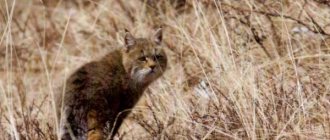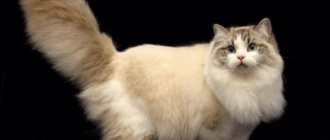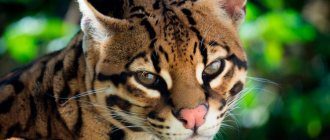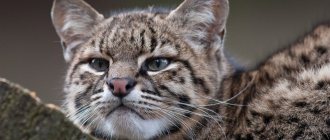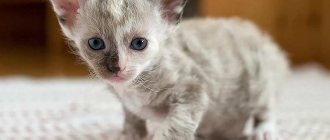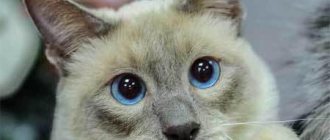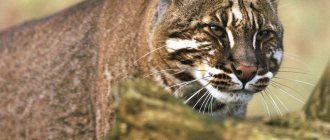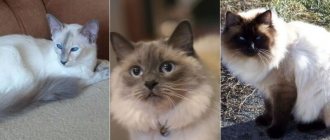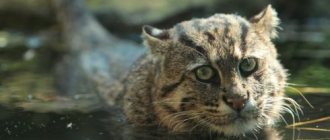The ocelot is a beautiful medium-sized wild cat from the Felidae family. It lives in the southern United States, Central and South America, and the Caribbean islands. In appearance and color it resembles a smaller version of a leopard. In recent years, thanks to its bright, unusual color, this wild cat has gained popularity as a pet.
Description and features
The name "ocelot" comes from the Aztec word ocelot, which is translated from the Indian as jaguar. According to another version, the name of the animal comes from the Latin word ocellatus, which means “marked with eye-shaped spots.” It sounds quite complicated, but it is a reference to the spotted color of the animal.
The first scientific description of the predator was made by the Swedish zoologist Carl Linnaeus in 1758, he named the animal Felis Pardalis. In 1858, British zoologist John Edward Gray proposed placing the predator in the genus of South American cats (Leopardus). This is how the modern scientific name of the ocelot appeared - Leopardus pardalis. Despite the name Leopardus and external similarity, the genus South American cats belongs to the subfamily of small cats (Felinae), and is in no way related to the leopard. The closest relative of the ocelot is the long-tailed cat (margay).
Varieties
Scientists identify 11 subspecies of ocelot:
- Leopardus pardalis aequatorialis inhabits the northern part of the Andes;
- Leopardus pardalis albescens is native to Texas and Mexico;
- Leopardus pardalis maripensis lives in Guyana and Venezuela;
- Leopardus pardalis mearnsi is ubiquitous throughout almost all of Central America;
- Leopardus pardalis mitis occupies Argentine and Paraguayan lands;
- Leopardus pardalis nelsoni is of Mexican origin;
- Leopardus pardalis pardalis lives along the banks of the Amazon;
- Leopardus pardalis pseudopardalis calls Colombia its home;
- Leopardus pardalis puseaus is native to Ecuador;
- Leopardus pardalis sonoriensis lives in Mexico;
- Leopardus pardalis steinbachi inhabits Bolivian territory.
The ocelot also has two related species:
- The serval (Leptailurus serval) is an African relative of the ocelot;
- The fishing cat (Prionailurus viverrinus) is a wild cat native to the remote tropical forests and wetlands of Pakistan, India, Sri Lanka and Indonesia.
What does an ocelot look like - size and appearance
The ocelot is a medium-sized wild cat. The length of the body of the animal, including the head, is from 55 to 100 cm, the length of the tail is on average from 30 to 45. The predator reaches a height of 40-50 cm at the withers. Females weigh from 7 to 12 kg, males weigh from 7 to 15.5 kg.
Ocelot fur can have a yellowish, reddish, grayish or reddish tint. There are many dark spots on the animal's skin - small spots on the head and limbs, and large spots in the form of rings or stripes on the back and sides. Several dark stripes usually stretch from the scruff of the neck to the very tail of the cat. The fur on the neck and belly is white.
The ears are black with a large white spot in the middle. The white spot is a false eye, protection from attacks from predators from behind. The coat is quite short, hair length no more than 1 cm, and the hair on the back is slightly longer. The ocelot smells quite strongly, this should be taken into account before keeping the animal at home.
In appearance, the ocelot can easily be confused with margay and oncilla, although the ocelot is noticeably larger and heavier, plus it has a shorter tail. The ocelot is comparable in size to the lynx and serval, and noticeably smaller than the jaguar. Many people confuse the ocelot with the serval. The serval is easily distinguished by its large ears and long limbs, plus the serval lives in Africa, not America.
Despite its cute appearance, the ocelot is good at biting. The bite force coefficient relative to the animal's body weight is 113.8. In terms of relative bite force, the ocelot is comparable to the hyena (113) and lion (112), and is noticeably ahead of some other felines - leopard (94), puma (108), jaguarundi (75) and lynx (100).
Life in captivity
Sometimes ocelots are kept at home, like ordinary domestic cats. It is difficult to purchase an ocelot; its price can reach 15–20 thousand dollars. However, if a person decides to make such a purchase, he will need to provide the cat with all the necessary conditions.
It will be difficult for a person to create suitable conditions for keeping a wild cat
The first thing the owner of a domesticated predator should remember is the ocelot mode. The cat will sleep during the day and hunt at night. It is difficult to force an ocelot to change these principles, this is how his nature works. It should also be understood that the ocelot is a proud animal, it cannot be offered “some” conditions, it will only be able to behave well if it is kept in an ideal manner.
It will be difficult to keep a large wild cat in an apartment. An animal needs a lot of space to play, run and express its hunting instincts. Of course, plenty of space and fresh air are very similar to the animal's natural habitat. But in most regions of Russia the climate is cool. Therefore, if we are talking about a private house, then in the enclosure you can install a heated shelter for the cat. And in winter, even such a shelter will not save the heat-loving predator from the Russian cold (the cat will need to be kept at home). The enclosure itself must be well fenced, safe, and must contain elements reminiscent of a wild environment (trees, snags, grass, stones, etc.).
If you do not give the ocelot a suitable and spacious place, the animal may become depressed or sick. If the owner tries and does everything at the highest level, the cat will not be in debt. There are many stories about how the ocelot became tame and affectionate, like an ordinary pet.
Video: ocelot communicates with its owner
Features of ocelot care
An ocelot kept in an apartment will run across sofas, tables and cabinets. The size of the cat will not allow this to be done gracefully, so the owner needs to immediately remove everything that breaks. In order for an animal to become tame and docile, it must be raised methodically and from early childhood. It needs to be petted, it needs to be played with while sitting on the floor, it needs to be hand-fed, etc. However, even if these conditions are met, the ocelot still needs the street. If the cat owner does not have his own area, then the ocelot can be walked like a dog. Of course, this requires a collar and a strong leash. Leash training needs to be done from a very young age.
You can't hit a jungle cat; he might harbor a grudge. All attempts on the part of a person to “reason” with a stupid animal will be perceived as aggression, and this will interfere with the educational process. This cat needs toys. Small balls intended for indoor cats are not suitable (the cat may swallow them). The ocelot needs toys of the size that are sold for dogs.
Neighborhood with other animals in the apartment is unlikely to be possible. In addition, the smaller the other pet, the more likely it is to be eaten. On the other hand, large animals (for example, dogs) may be perceived as rivals for territory. They won't be able to be friends anyway. When it comes to children, things are even more complicated. Ocelots are afraid of children, so they will try to hide in corners, closets, etc. And if a child inadvertently offends the animal, it may scratch or even bite.
The ocelot's animal instincts remain even when he gets into a person's house
Unlike some domestic cats, ocelots are easily litter trained. The cat needs to be immediately shown where to go to the toilet and where not to go. For the convenience of the animal (and so that you do not have to frequently wash near the potty), the tray should be purchased taking into account the size of the animal. For such large cats, litter trays designed for dogs or large cats (such as Maine Coons) are suitable. The correct choice of tray also determines whether the house will smell.
The smell of a cat in the house may also be due to the fact that the animal has begun to mark its territory. To prevent this from happening, it is advisable to castrate the ocelot in childhood (from 6 months). Of course, this is provided that the cat is not kept in a nursery (zoo) and is not threatened with mating. It is also advisable to vaccinate your animal. The owner can consult a veterinarian about vaccinations. The main thing is that the vaccine must not be live.
The owner of an American cat should also know that each individual must have documentation. This is a mandatory condition for keeping wild animals listed in the Red Book. If the owner does not have documents on purchase, the ocelot will be considered purchased illegally (from hand). Such an animal can be seized without the consent of the owner. The animal will end up in a zoo or be released into its native environment, and the owner will be subject to administrative punishment.
In our city (Penza), the discovery of rare animals in someone’s home becomes real news. If the owner of the animal does not have documents, then such an event is called a crime and is covered on all local television channels. I believe that such examples should encourage future owners of ocelots to legally purchase them.
the owner of the ocelot must have documents confirming the purchase of the animal
What to feed your pet ocelot
The ocelot's diet should be close to natural. Most of the diet should consist of protein foods. Feral cats are usually given meat, but offal is also suitable. The meat can be beef, veal or poultry. Pork is a prohibited type of meat. The volume of the daily diet is determined based on the cat’s body weight (3–5% of meat by weight). If an ocelot weighs 10 kilograms, then it should receive at least 300–500 grams of fresh meat.
An important requirement for meat is that it must have bones. Therefore, sometimes offal is even better than pulp, for example, beef. Chicken by-products (necks, wings, etc.) contain many small bones, so this bony food most closely resembles the usual food of ocelots. However, the menu should be varied. It is recommended to alternate these products.
I have friends who keep a wild cat at home (although it comes from Africa). Any wild animals should be fed raw meat. Indeed, at first they only bought fresh beef and veal for that cat. Over time, friends began to understand that it would be very difficult to maintain such a diet. Now they buy broiler carcasses from the poultry farm's wholesale warehouse. They had to purchase a separate freezer, but the manufacturer gives a good discount. Chicken meat costs my friends the price of offal.
In addition to protein food, your cat can be given seafood or dry cat food. Wild cats are not prone to obesity, so the cat will not overeat in any case. If possible, you can purchase food mice or rats. This option is the most favorable, but such products can be difficult to obtain. With proper care and feeding, an ocelot can live up to 25 years in a home environment.
Video: Ocelot of the Novosibirsk Zoo
Where does the ocelot live?
The ocelot lives in Central and South America, from the southern United States to northern Argentina. The predator lives in tropical forests, mangrove swamps, and savannas. Found at altitudes up to 3,000 meters. As a habitat, it prefers dense tropical thickets with a large amount of potential prey, close to a body of water. The animal avoids steep slopes and highlands, as well as open spaces. Most ocelots live in the tropics - in areas with high humidity and high levels of precipitation, the animal is found more often than in drier or high-mountain areas.
The ocelot shares most of its habitat with other cats - the jaguar, jaguarundi, puma, margay and oncilla. To avoid competition and larger predators, the ocelot hides in dense foliage. Ocelots are highly adaptable and can therefore change their environment to follow their prey.
Save Status
Ocelot hunting was very popular in the 1960s and 1970s. In those days, about 200 thousand individuals died annually. Their skins are very valuable , and their fur is in demand in the clothing market. In subsequent years, people also began stealing young ocelots from their lairs to sell as pets.
Photo: City of Albuquerque
Although ocelots are still abundant in parts of Mexico and Central and South America, the current ocelot population consists of fewer than 100 individuals .
Overhunting and habitat destruction have significantly reduced the range and numbers of ocelots in Texas. Landscape changes during the twentieth century as a result of mechanical farming and deforestation fragmented the wildcat's range and created barriers to the dispersal of populations between South Texas and northern Mexico.
Ocelots are currently protected in the United States by the Endangered Species Act and worldwide by the Convention on International Trade in Endangered Species of Wild Fauna and Flora. But despite the ban on the trade in ocelot skins, they are still killed en masse.
An ocelot skin is known to be worth US$40,000 . With such demand, illegal poaching is likely to continue despite efforts to enforce restrictions. But as more people become aware of the shortage of small spotted cats in the wild, fur sales are facing growing social hostility that is dampening the fashion for cat skins.
- IUCN Status: Least Concern
- Red Listed in the United States: March 28, 1972
- Threats: poaching, habitat loss
Character and lifestyle
Ocelots, like other wild cats, tend to lead solitary lives. They are active at dusk and at night; during the day the animal rests in trees, in a hollow or in a secluded place in the thickets. Ocelots are excellent tree climbers and often escape from predators above. In addition, these cats, like jaguars, are excellent swimmers.
Ocelots usually live in their own territory, and actively defend their possessions from other individuals. The male's territory ranges from 3 to 46 square kilometers on average, the female's territory is several times smaller - up to 15 km. The hunting areas of females almost never intersect, but 2-3 females can live on the male’s territory at the same time. Adults can occasionally communicate with each other outside the mating season; in addition, young animals often live with their mother.
Behavior
Photo: Ben
Ocelots are nocturnal and very territorial. They mark their territory with urine and guard it fiercely. Ocelots often fight each other to the death because neither opponent wants to give up.
These wild cats spend the day resting in trees and only go hunting at night. They must always be aware of other ocelots and predators because they themselves are easy prey . Even in leafy areas, ocelots move incredibly quietly thanks to the soft pads under their paws.
Excellent swimming skills are a characteristic feature that distinguishes ocelots from other cats (except jaguar and tiger).
What does an ocelot eat?
Ocelots track prey by scent, moving slowly through the forest in search of potential prey. This is a cunning and patient hunter; he is able to wait for hours for an opportune moment to attack. The predator prefers to hunt in dense vegetation, and avoids going out into open spaces so that the prey does not notice it.
Like other wild cats, ocelots eat exclusively meat. The animal's diet is based on small mammals - armadillos, opossums, rodents, monkeys, hares and rabbits. They also eat fish, reptiles, insects and small birds. Typically, ocelots prefer to hunt small animals weighing less than 1 kg, but from time to time they can hunt larger prey - a small deer, sheep or peccary. The cat strangles small prey by the neck, knocks down larger prey and cuts the tendons so that it does not run away, then strangles it. On average, an ocelot eats about 600-800 grams of meat per day. After a successful hunt, it eats the prey immediately.
The ocelot's diet varies significantly depending on the animal's habitat and time of year. In the tropical forests of Mexico, the ocelot most often hunts the iguana; in the southeast of Brazil, the predator prefers monkeys. In Venezuela, ocelots hunt rodents and iguanas during the dry season; during the rainy season, cats switch to land crabs.
Eating habits
The ocelot is a carnivore that tracks prey by smell. It feeds on a variety of small mammals and birds, as well as some reptiles, amphibians, crustaceans and fish. The menu of ocelots includes: guinea pigs, spider monkeys, parrots, opossums, armadillos, anteaters, agouti, iguanas, lizards, snakes, turtles. Large individuals can kill a small donkey or wild boar.
Sometimes wild cats make their way into agricultural lands, where they like to feast on young pigs, kids, lambs, and chickens. Rabbits, rats and mice of many species are important parts of their diet.
Reproduction and young
Ocelots breed all year round. The peak mating season occurs at different times of the year depending on the animal’s habitat: autumn in Paraguay and Argentina, autumn and winter in Mexico and the southern United States. Estrus in females lasts 4-5 days out of a 25-day cycle. Predators attract each other by meowing and loud howls, and also leave scent marks to find a partner.
Pregnancy lasts approximately 2-3 months, with 1 to 3 kittens born in a litter. Females give birth in a den, usually in dense thickets. Newborn kittens weigh about 200-350 grams. The cubs are born blind and helpless; the kittens' eyes open at 15-18 days. Kittens are born with a spotted pattern, but the main fur color of the cubs is gray. Over time, the skin acquires a brighter yellow or red tint. At the age of 3 months, the cubs begin to leave the den. Young ocelots stay with their mother for up to 2 years, then go in search of their own territory.
Interesting Facts
- Ocelots were first described by the Swedish naturalist Carl Linnaeus in 1758. Later, due to the characteristic color of the animals, the species was assigned to the genus Leopardus (South American cats). In fact, ocelots have very little in common with leopards, which are big cats. Their closest relatives are margai.
- On the back of the ocelot's ears there are small white spots called "false eyes". White fur, clearly visible among the greenery, misleads the enemies of wild cats, and also helps the cubs determine the location of the mother.
- Ocelot means “field tiger” in the Aztec language. Why the Indians gave such a name to an animal that prefers to live in dense vegetation and does not appear in open areas still remains a mystery.
- Unlike other cats, ocelots remove fur and feathers before eating prey. Since 400-500 grams of meat per day is enough for dwarf leopards, they hide the remains of the carcasses from other predators so that they can then return and finish eating.
- Counting the ocelot population poses certain difficulties, since the most populated areas are the impenetrable Amazon jungle. As a result, abundance data may vary greatly. Today in various sources you can find figures from 800 thousand to 3 million individuals.
Ocelot species
In the first half of the 20th century, scientists identified 9 subspecies of ocelot, based on differences in the color and pattern of spots in the animals. In 1998, as a result of DNA research, 4 breeds of ocelots were identified, depending on their habitat:
- Central America
- Northwestern South America
- Northeastern South America
- South America south of the Amazon
A 2010 study found significant morphological differences between South and Central American individuals. In 2021, the Commission on the Classification of Felines of the International Union for Conservation of Nature recognized only 2 breeds of ocelots.
- L.p.
pardalis . It is distinguished by a grayish tint of fur. Found from the southern United States to Costa Rica. - L.p.
mitis . It has a yellowish color and is larger in size than pardalis. Lives in South America to northern Argentina.
The range of the ocelot and its role in the ecosystem
Ocelot populations occupy some areas of South America (Bolivia, Argentina, Peru, Brazil, etc.) and the USA. Previously, there were more ocelots, they inhabited Louisiana, Arkansas and Arizona. Currently, only scattered groups of ocelots remain in Texas. True, sometimes single individuals move from Mexico to Arizona.
The largest population of dwarf leopards lives near the Amazon. The American River basin has dense jungle. Although the ocelot can adapt to any warm conditions where there is someone to hunt. Therefore, ocelots sometimes inhabit tropical meadows, mangrove jungles and swamps. The main condition for the territory is the presence of dense vegetation. There were cases when the ocelot came very close to populated areas.
Typically, spotted cats live at an altitude of no more than 1,200 meters above sea level, but some groups have been found on the high slopes of the Andes (up to 3,800 meters).
Video: ocelot fishing
The ocelot, like any other predator, occupies not the last place in the food chain. Most ocelots feed on terrestrial species. These predators exterminate rodents, which are considered pests of agricultural land. Rodent control is especially important in areas where people live. However, this ability of ocelots sometimes turns against them. Wild cats can become carriers of parasites (Toxocara, Paragonimus, etc.). Tropical parasites are dangerous not only for the ocelot, but also for humans who may come into contact with the jungle cat.
A dwarf leopard can also become food for larger predators (for example, a jaguar). Ocelots themselves and their abusers can fertilize the soil with excrement. This is also an important point, especially in drier areas (like Mexico). This explains the important role of the ocelot in the ecosystem.
Natural enemies of the ocelot
The ocelot has many natural enemies. In the wild, the ocelot is attacked by bobcats, jaguars, coyotes, wild dogs, wild boars, alligators and pythons, as well as large birds of prey (eagles and condors). Humans pose a significant danger to the animal. Due to agricultural expansion, the food supply of the predator and its habitat are decreasing. Danger is also posed by poachers who kill animals for their skins, and hunters who shoot predators to save livestock.
Nutrition
Ocelots usually prey on small rodents and birds. Predators can sit on a tree for hours, patiently stalking their prey. And then they kill their prey with one quick and precise bite. It is interesting that the ocelot cat does not chew its food. With sharp teeth, he tears off the fibers of meat from a piece and simply swallows them.
Population and species status
The ocelot is listed as a species of least concern on the International Red Book. Currently, the total number of animals in the world is estimated at 40,000 individuals. Stable populations are observed in Argentina, the Amazon, Colombia, Venezuela and the Andes. In northern Mexico and Texas, animal numbers have declined significantly in recent years due to human expansion.
Hunting for the predator is prohibited in Argentina, Brazil, Bolivia, Costa Rica, Suriname, Uruguay, Colombia, Guatemala, Honduras, Mexico, French Guiana, USA, Trinidad and Tobago, Venezuela, Nicaragua and Panama. In Peru, hunting is permitted with restrictions. Hunting is allowed in Ecuador and El Salvador.
Did you know?
- The lifespan of ocelots is 12-15 years (20 years in captivity).
- Juveniles often become prey for boa constrictors, pumas, jaguars, anacondas, caimans and South American harpies.
- This is the only cat that sleeps like a dog. He curls up and puts his head on his hind legs.
- The Moche people of pre-Columbian Peru worshiped ocelots, and their depiction can often be found in Peruvian art.
- The ocelot is an excellent climber, able to scale a tree in a matter of seconds.
- The ocelot swallows food in chunks because it cannot chew. Before eating a bird, he plucks it with his teeth and paws.
- There are currently up to 1.5 million ocelots in the world.
- Every day, ocelots cover a distance of up to 11 kilometers.
Ocelots as pets
It is quite possible to tame an ocelot and keep it at home if you take the kitten small, under the age of 3-4 months. If a kitten is not accustomed to people from a young age, it will grow up to be wild. This is one of the most expensive cats in the world. The price of a kitten averages 10 - 12,000 dollars, the price in Russia is about 1 million rubles. Ocelots are much more expensive than servals (450-500 thousand rubles) or lynxes (150-200 thousand).
Ocelots are active and energetic cats, so they require a lot of attention from their owners. Cats love to chew and bite various objects, such as their owners' fingers or clothes. May swallow small objects such as tennis balls if not supervised. Ocelots are affectionate and very cute animals, but they are too playful - they can destroy the entire house in a fit of energy, or accidentally bite their owners.
Salvador Dali had a pet ocelot named Babu. The artist took it with him everywhere, even on board an ocean liner. When in New York, visitors to a restaurant where Dali was dining were somehow frightened by an ocelot, the artist said that it was an ordinary domestic cat, which he had personally painted in the style of modern art.
Purchasing an Ocelot kitten, price
An ocelot is a very expensive acquisition, both in terms of the cost of the purchase itself (15-20 thousand dollars) and in terms of the conditions of full maintenance.
In addition, you should buy an Ocelot for home keeping only in specialized nurseries, which are found all over the world, including in Russia and Ukraine. If the animal does not have a complete set of necessary documents, the animal, according to the new laws, is subject to seizure by government agencies, and the owner will suffer administrative punishment.
How to buy an Ocelote kitten
What is the price? The price for representatives of the species remains high ($15-20 thousand). Providing adequate living conditions for your pet is also not easy. Purchasing wild animals is allowed only in special nurseries that provide correctly completed documents. In the absence of the necessary documents, the predator is confiscated by government organizations, and the buyer is subject to administrative punishment.
